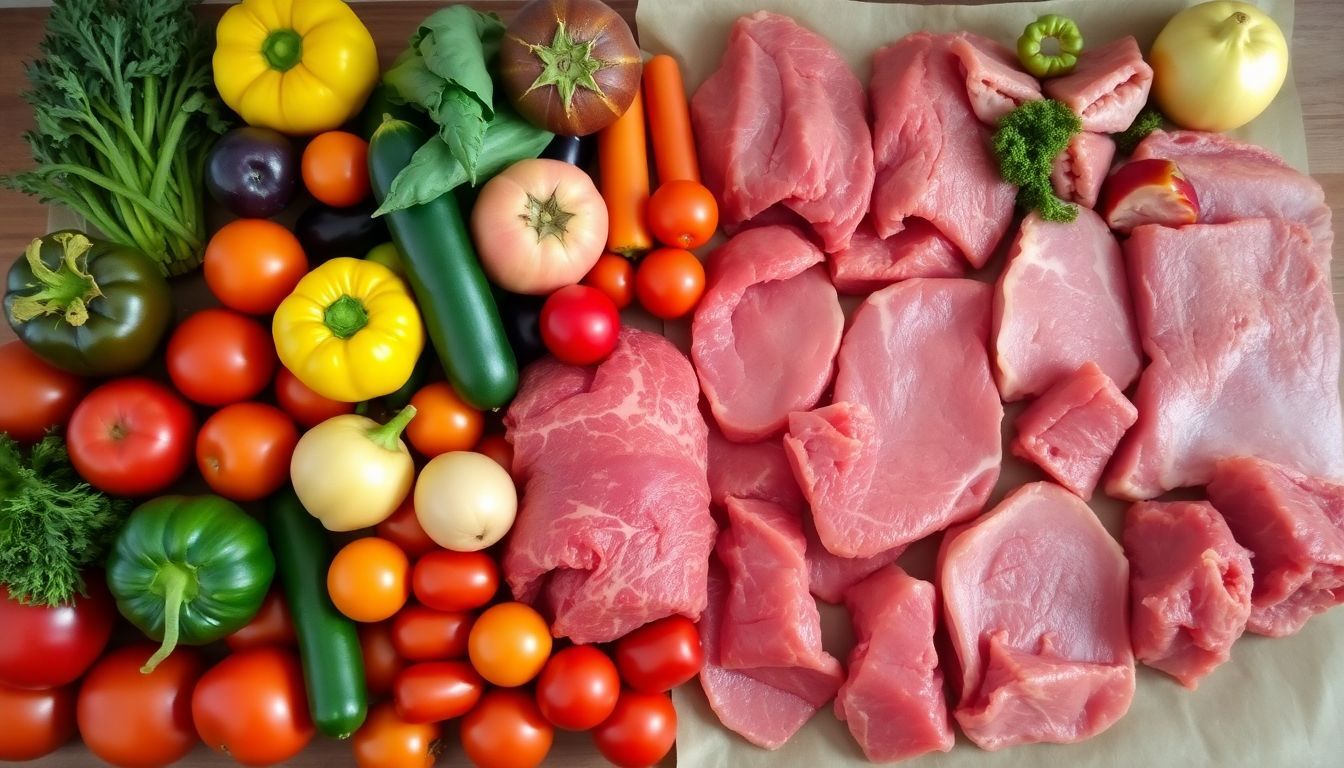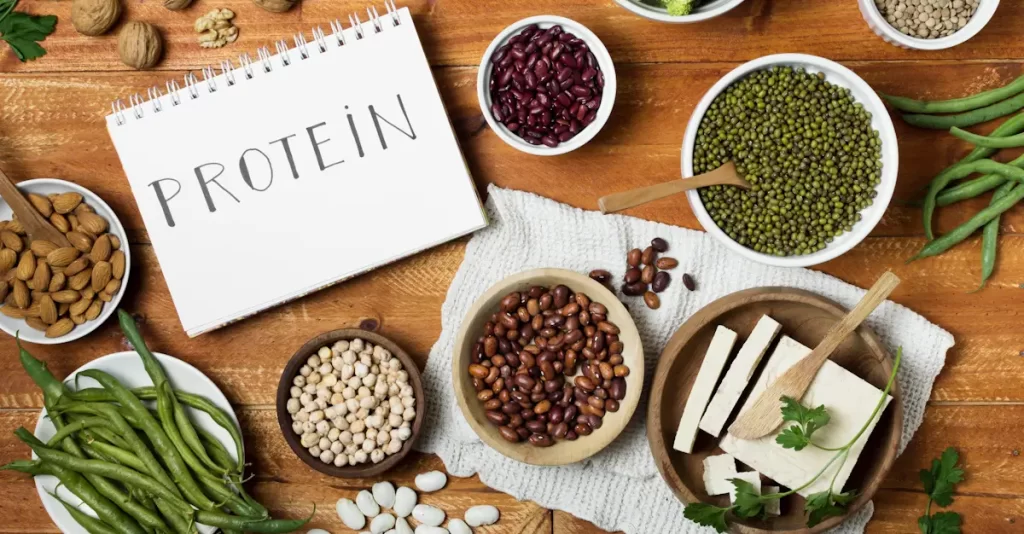Many people worry about eating too much meat and its impact on their health. Studies show that replacing animal protein with plant-based foods can lower the risk of heart disease. This article explains the difference between plant and animal protein and how making small changes can improve your life.
Thank you for reading this post, don't forget to subscribe!Keep reading to learn how plants may help you live longer!
Key Takeaways
- Replacing just 3% of daily calories from animal protein with plant protein lowers the risk of premature death by 10%. It also cuts cardiovascular disease deaths by 27%.
- Plant-based proteins, like beans and nuts, reduce LDL cholesterol by about 4% and lower inflammation. This helps prevent heart disease, type 2 diabetes, and obesity.
- High intake of red or processed meat increases risks for heart diseases, diabetes, and early death. Shifting to legumes or whole grains improves health markers like insulin sensitivity.
- Eating plant proteins uses fewer resources. Producing them reduces water consumption by up to 99% compared to red meat production while cutting greenhouse gas emissions significantly.
- Combining different plants like rice and beans ensures complete amino acid profiles without relying on animal products. Simple swaps can improve both personal health and environmental sustainability.
The Nutritional Composition of Plant vs. Animal Protein
Plant protein and animal protein differ in their nutrient profiles. While plant proteins often come with fiber, animal proteins usually contain more saturated fats.
Key nutrients in plant-based proteins
Plant-based proteins are packed with fiber, vitamins, and minerals. They also contain antioxidants and healthy fats that support overall health. Unlike animal protein, plant foods are naturally cholesterol-free.
This makes them beneficial for heart health.
They feature anti-inflammatory properties too, which can reduce risks of chronic diseases like type 2 diabetes or cardiovascular disease. Beans, lentils, nuts, seeds—these all offer impressive nutrient profiles while being easy to add to meals…
Next: **Essential amino acids in animal proteins**
Essential amino acids in animal proteins
Animal proteins contain all nine essential amino acids. These include lysine, tryptophan, and methionine. Your body cannot make these on its own—they must come from food. Beef, chicken, eggs, fish, and dairy are excellent sources of complete dietary protein.
Higher animal protein intake can affect long-term health. It raises IGF-1 (Insulin-like Growth Factor 1) levels in the body. This hormone is linked to chronic diseases like cancer and type 2 diabetes.
While nutritious in some ways, large amounts of red meat or processed meat may raise health risks over time.

Health Benefits of Plant-Based Protein
Plant-based proteins support better health in many ways, from heart wellness to gut strength. They help fight disease while boosting your body’s overall function.
Lower risk of cardiovascular disease
Eating more plant-based protein can cut the risk of cardiovascular disease (CVD). Studies show that a 1:1.3 ratio of plant to animal protein leads to 19% lower CVD risk and 27% lower coronary heart disease (CHD) risk.
Boosting total protein intake to about 21% with higher ratios of plant protein drops CVD risk by 28%. CHD risks go down even further, by up to 36%.
Swapping red meat for beans, lentils, or soy reduces saturated fat intake. This change improves heart health. Processed meat often harms cholesterol levels, while whole food options like nuts and seeds support better blood lipids.
A balanced diet rich in dietary proteins from plants benefits the heart significantly.
Your choices today shape your heart’s tomorrow.
Improved cholesterol levels
Switching from animal protein to plant-based protein can improve cholesterol levels. Studies show replacing 1-2 servings of red meat or processed meat with plant proteins reduces LDL cholesterol by about 4%.
This drop equals a decrease of 0.16 mmol/L in “bad” cholesterol levels and 0.18 mmol/L in non-HDL cholesterol.
High LDL cholesterol leads to heart disease over time, making these small changes important for long-term cardiovascular health. Plant-based foods like soybeans, legumes, and whole grains offer a healthier alternative without the saturated fat found in many animal protein sources.
Reduced inflammation
Plant-based protein lowers inflammation markers like IL-6 and CRP. Studies show participants with chronic kidney disease (CKD) on a plant-rich diet had reduced C-reactive protein levels.
Lower CRP means less inflammation, which protects your body.
Animal proteins often trigger more inflammatory responses. Shifting to foods like legumes, nuts, or soy protein can reduce this risk. Over time, consuming plant-based diets helps combat issues tied to swelling and pain in the body.
Enhanced gut health
Fiber-rich plant-based foods improve gut health. High fiber content in pea proteins, legumes, and whole grains promotes the growth of good gut bacteria. A healthy microbiome strengthens digestion and nutrient absorption.
It also supports weight management and reduces risks linked to obesity.
Eating less red meat lowers gut inflammation. Processed meat may trigger harmful bacteria in the digestive tract, leading to discomfort or chronic issues. Switching protein sources improves both digestion and overall well-being…leading to fewer risks tied to animal protein impacts on health!
Impact of Animal Protein on Health
Eating too much animal protein, like red or processed meat, has been linked to higher risks of health problems. Keep reading to learn how these choices impact your body.
Association with heart disease
High intake of animal protein, especially from red and processed meat, may increase the risk of heart disease. Saturated fat in these foods raises LDL cholesterol, a key factor in cardiovascular health problems.
Studies show that replacing animal proteins with plant-based options like nuts or legumes lowers heart disease risk by up to 19%. This swap also improves cholesterol levels while reducing inflammation linked to chronic diseases.
Links to diabetes and obesity
Animal protein, especially red and processed meats, is tied to higher rates of type 2 diabetes. These foods can increase insulin resistance due to their saturated fat content. Studies show replacing animal protein with plant-based options lowers HbA1c by 0.15% and fasting glucose levels by 0.53 mmol/L in diabetics.
Obesity risks also rise with diets high in meat from a western diet pattern. Processed meats contribute to weight gain due to calorie density and low fiber content. Plant proteins like beans or nuts provide nutrients while helping manage weight effectively, reducing diabetes risk over time.

How Substituting Plant Protein Can Extend Lifespan
Switching to plant protein may lower disease risks and boost longevity—learn how small changes can have big impacts.
Reduced mortality rates
A higher intake of plant-based protein lowers the risk of premature death. Replacing just 3% of calories from animal protein with plant protein reduces early death risk by 10%. People consuming the most plant proteins showed a 27% lower rate of cardiovascular deaths.
Plant-based diets improve overall health, contributing to longer lifespans.
Eating more legumes, whole grains, and nuts instead of red or processed meat can make a big difference. These foods contain less saturated fat and fewer harmful compounds linked to heart disease and other chronic illnesses.
Making small changes in dietary patterns supports healthier living over time.
Prevention of chronic diseases
Switching animal protein with plant-based protein lowers the risk of chronic diseases. Studies tracking participants for up to 32 years show improved health outcomes from dietary changes over time.
For instance, less reliance on red and processed meat can reduce risks tied to heart disease, type 2 diabetes, and obesity.
Plant proteins help maintain healthy cholesterol levels and improve insulin sensitivity. Lower saturated fat intake further supports cardiovascular health. A diet rich in legumes, nuts, seeds, whole grains, and other plant-based foods promotes overall well-being while protecting kidney function—key in preventing renal issues like nephropathy or end-stage renal disease.
Positive effects on longevity biomarkers
Higher intake of plant protein supports better health markers linked to aging. Studies show it reduces inflammation, which slows down tissue damage over time. It also improves kidney function by lowering creatinine levels and boosting the estimated glomerular filtration rate (eGFR).
Replacing red or processed meat with plant-based foods cuts saturated fat intake, reducing hyperlipidemia risks. This shift can enhance metabolic functions and maintain healthy cholesterol levels—key factors in longevity.
A diet rich in legumes, nuts, and whole grains provides these benefits while promoting a longer life span.
Popular Sources of Plant Protein
Plant-based proteins come from many tasty and healthy foods. These options are rich in nutrients and easy to add to your meals!
Legumes and beans
Legumes and beans offer excellent plant-based protein sources. Lentils, chickpeas, black beans, and soybeans are high in protein quality. They also have balanced amino acid profiles with notable Protein Digestibility Corrected Amino Acids Scores (PDCAAS).
These foods provide essential nutrients like fiber, iron, magnesium, and B vitamins—supporting heart health and improving gut function.
Global demand for legumes is growing fast. The market for plant-based foods—including beans—is expected to reach $162 billion by 2030. Their versatility makes them easy to include in meals: think soups, salads, or even spreads like hummus.
Nuts and seeds
Nuts and seeds help improve heart health. They lower bad cholesterol levels and reduce the risk of cardiovascular diseases. Diets rich in these plant-based foods are linked to a lower chance of type 2 diabetes.
Walnuts, almonds, chia seeds, and flaxseeds stand out as nutrient-rich options.
These small powerhouses pack protein, healthy fats, fiber, vitamins, and minerals. They work well in many dietary patterns by boosting nutrition without adding saturated fat found in red meat or processed meat.
Including just a handful daily can support overall health while fitting easily into most diets.
Whole grains
Whole grains offer a rich source of plant protein, fiber, and essential nutrients. They include options like quinoa, brown rice, oats, barley, and whole wheat. These foods contain complementary proteins that help balance amino acids in a plant-based diet.
Fiber in whole grains promotes gut health and aids digestion while improving cholesterol levels.
Eating more whole grains may lower the risk of heart disease and type 2 diabetes. Unlike processed foods, they provide sustained energy without spiking blood sugar levels. Whole grain bread or oatmeal can easily replace refined grains for a healthier option.
Plant-based meat alternatives
Plant-based meat alternatives mimic the taste and texture of real meat. They are made from protein sources like soy, peas, or wheat. These substitutes appeal to meat lovers who want a healthier option.
Companies such as Beyond Meat and Impossible Foods have gained popularity for creating burgers that closely resemble beef.
These products often contain less saturated fat compared to red meat, which supports better heart health. Some options include added nutrients like iron and B12 to match animal protein benefits.
Plant-based meats may reduce risks of chronic diseases linked to processed meats while being kinder to the environment.
Seaweed: A Tasty, Nutritious Snack Packed with Health Benefits
Seaweed stands out as a nutrient-packed plant-based food. Unlike some plant protein sources, it offers all essential amino acids, making it a complete protein option. It’s low in calories but rich in vitamins like A, C, and E—plus minerals such as iodine and calcium that support thyroid and bone health.
Beyond nutrition, seaweed contributes to global food security. Its versatility makes it popular in functional foods and nutraceuticals. Snack on dried nori sheets or add kelp to soup for flavor and nutrients.
Comparing Digestibility: Plant vs. Animal Protein
Plant proteins can be harder for the body to break down due to factors like fiber and natural compounds. Animal proteins, on the other hand, are easier to digest but may have long-term health impacts.
Digestibility scores of plant proteins
Digestibility of plant proteins depends on their type. They fall into three groups: Rapidly Digestible Proteins (RDP), Slowly Digestible Proteins (SDP), and Resistant Proteins (RP).
RDP breaks down quickly in the gut, while SDP takes more time. RP resists digestion altogether, lowering absorption rates.
Processing methods can increase digestibility. For example, soaking or sprouting beans and grains helps convert RP into RDP or SDP. This makes nutrients easier for the body to use.
Though animal protein often scores higher in digestibility tests, improving plant protein processing narrows this gap significantly.
Improving plant protein absorption through preparation techniques
Plant proteins are healthy, but they can be harder to digest. Proper preparation methods can improve their absorption and nutrition.
- Soaking beans and legumes before cooking helps reduce antinutrients. This makes it easier for your body to absorb key minerals like iron and zinc.
- Sprouting grains, seeds, and legumes boosts digestibility. It also raises their levels of vitamins like B and C.
- Fermenting foods like soybeans enhances digestion and adds good bacteria for gut health. Miso and tempeh are great examples of fermented plant-based foods.
- Cooking at the right temperature lowers substances that block nutrient absorption, such as phytates. For example, boiling lentils breaks down these blockers.
- Combining different plant protein sources ensures all essential amino acids are present in your meal. Mix rice with beans or peanut butter with whole-grain bread for a complete protein.
- Grinding seeds like flax or chia makes them easier to digest while keeping their nutrients intact.
- Marinating tofu or other soy products in acidic bases (like lemon juice) helps unlock more nutrients for your body to use.
- Using enzymes from foods like pineapple (bromelain) or papaya (papain) can aid in breaking down plant proteins during digestion.
- Pairing vitamin C-rich foods, such as bell peppers or oranges, with plant iron sources boosts iron absorption significantly.
- Avoid pairing high-calcium foods with plant proteins at the same time if you want better iron uptake—calcium blocks its absorption temporarily.
Environmental Benefits of Choosing Plant Protein
Eating more plant protein can help protect the planet. It uses fewer resources like water and land, making it a greener choice.
Lower carbon footprint
Choosing plant protein over red meat cuts emissions. If alternative proteins take up half of the global market by 2050, CO2 emissions could drop by 5 gigatons annually. Replacing 20% of ruminant meat with plant-based options can slash deforestation rates in half yearly.
Producing animal protein uses more resources and creates more greenhouse gases. Livestock farming contributes heavily to methane release, which worsens climate change. Shifting dietary patterns toward plant-based foods has a more minor environmental impact while supporting cardiovascular health and reducing chronic diseases.
Reduced water usage
Plant-based foods use far less water than animal protein sources. Plant-based meat alternatives can cut water consumption by up to 99% compared to red meat like beef. Livestock farming also demands large amounts of freshwater for drinking, feed production, and processing.
Agriculture overall takes up 70% of global freshwater withdrawals, with a huge portion going toward raising animals for food.
Switching to plant proteins from sources like legumes, nuts, and whole grains helps conserve precious resources. For example, growing beans requires significantly less water than producing processed meat or dairy products.
Choosing more sustainable dietary patterns reduces the strain on limited water supplies while supporting better health.
Mitigating deforestation risks
Shifting 20% of ruminant meat consumption to alternative proteins by 2050 could cut yearly deforestation in half. This change would also reduce carbon emissions tied to land clearing for animal agriculture.
Less demand for red meat means fewer forests converted into grazing lands.
Transitioning to plant protein may help free up massive areas of land—equivalent to twice the size of China and India—for reforestation efforts. Restoring forests improves air quality, removes CO2, and supports biodiversity.
Popular sources like legumes or nuts can meet protein needs without harming ecosystems.

Tips for Transitioning to More Plant-Based Protein
Switching to more plant-based protein can be simple with small steps. Focus on adding variety to meals and experimenting with different ingredients.
Gradual reduction of animal protein intake
Cutting back on red meat and processed meat can boost overall health. Start small—replace one or two meals a week with plant-based protein sources like beans, lentils, or tofu. Even swapping 3% of daily calories from animal protein to plant protein lowers the risk of premature death by 10%.
Focus on balance to avoid missing key nutrients. Combine whole grains, nuts, and seeds for complete proteins that mimic those in animal products. Over time, reducing saturated fat from animal foods improves heart health and may help prevent chronic diseases like type 2 diabetes and obesity.
Balancing plant protein sources for complete nutrition
Combining plant foods is key for complete nutrition. Plant-based proteins, like beans, nuts, and grains, may lack one or more essential amino acids. For example, beans are low in methionine but high in lysine; rice has the opposite profile.
Eating them together creates a full amino acid profile.
Variety ensures better protein quality without relying on animal products. Pair lentils with whole grains or hummus with whole-grain bread to meet your body’s needs. This mix benefits human nutrition while supporting cardiovascular health and lowering chronic disease risk…
Moving forward into tasty plant protein options—legumes and seeds offer great choices!
Incorporating plant-based meals into daily routines
Start with small changes. Replace red meat or processed meat with plant-based foods like beans, lentils, or tofu in meals. Swap half your grain intake for whole grains such as barley or wild rice to add fiber and nutrients.
Experiment with plant-based protein sources to keep it interesting. Use nuts, seeds, or chickpeas in salads and soups. Try plant-based alternatives like veggie burgers for a convenient option on busy days.
Conclusion
Switching to plant protein can change your health. It lowers the risks of heart disease and chronic illnesses. Plant-based foods are rich in fiber, vitamins, and healthy fats—giving you more than just protein! Adding more plants to your plate may extend your life while protecting the planet.
Small changes in what you eat can make a big impact on your future.
Discover the myriad of health benefits that seaweed offers by checking out our detailed guide on why seaweed is a tasty and nutritious snack packed with health benefits.
